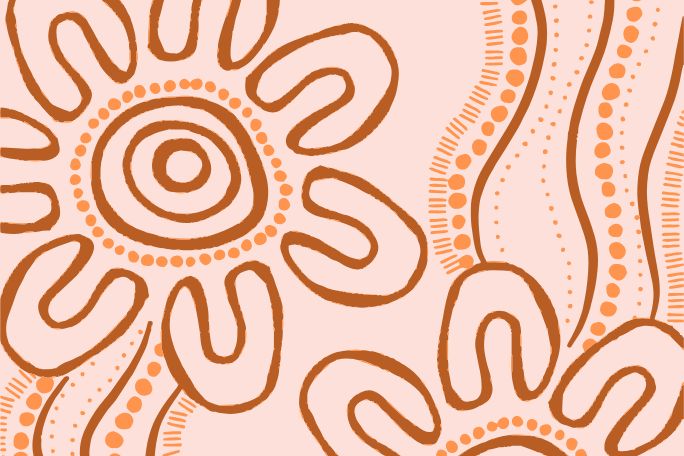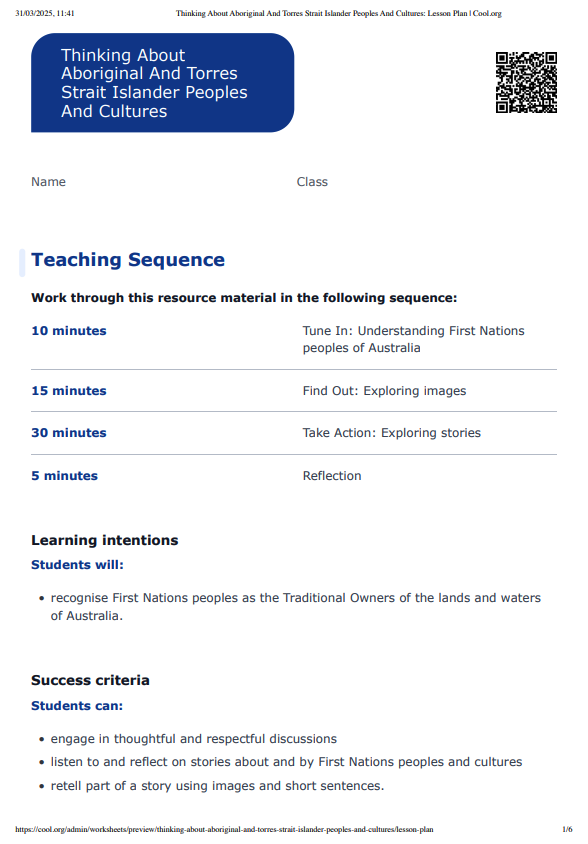Lesson summary
Students will explore Aboriginal and Torres Strait Islander peoples as the Traditional Owners of Australia’s lands and waters. They will also explore peoples and cultures in contemporary contexts and listen to and respond to a story by an Australian First Nations author.
Learning intentions
Students will:
- recognise First Nations peoples as the Traditional Owners of the lands and waters of Australia.
Success criteria
Students can:
- engage in thoughtful and respectful discussions
- listen to and reflect on stories about and by First Nations peoples and cultures
- retell part of a story using images and short sentences.
Lesson guides and printables
Curriculum links
Select your curriculum from the options below.
Lesson details
Skills
This lesson is designed to build students’ competencies in the following skills:
- creative thinking
- communication
- empathy
- ethical understanding
- intercultural understanding.
Curriculum Mapping
Australian Curriculum (v9.0) content description:
F-2, Geography
Students learn:
- the importance of Country/Place to First Nations Australians and the Country/Place on which the school is located (AC9HSFK04)
- how places change and how they can be cared for by different groups, including First Nations Australians (AC9HS1K04)
- about the interconnections of First Nations Australians to a local Country/Place (AC9HS2K04).
English
- retell and adapt familiar literary texts through play, performance, images or writing (AC9EFLE05)
- orally retell or adapt a familiar story using plot and characters, language features including vocabulary, and structure of a familiar text, through role-play, writing, drawing or digital tools (AC9E1LE05)
- identify features of literary texts, such as characters and settings, and give reasons for personal preferences (AC9E2LE02)
Relevant parts of Foundation Year achievement standards: Students recognise the features of familiar places, why some places are special to people and the ways they can care for them. They create short written texts, including retelling stories using words and images where appropriate.
Relevant parts of Year 1 achievement standards: Students identify the location and nature of the natural, managed and constructed features of local places, the ways places change, and how they can be cared for by people. They share ideas and retell familiar stories, and express opinions using a small number of details from texts.
Relevant parts of Year 2 achievement standards: Students identify how people and places are interconnected both at local and broader scales. They share an appreciation of texts when they recount, including details from texts.
General capabilities: Intercultural Understanding
Cross-curriculum priority: Aboriginal and Torres Strait Islander Histories and Cultures
Level of teacher scaffolding: Medium - facilitate and model respectful class discussions, and select and read a First Nations story.
UN Sustainable Development Goals
UN SDG 10: Reduce inequality within and among countries
- Target 10.2: By 2030, empower and promote the social, economic and political inclusion of all, irrespective of age, sex, disability, race, ethnicity, origin, religion or economic or other status
Resources Required
- Drawing and writing materials
- Picture book written by a First Nations author - select one that is suitable for the age and stage of your students. (Check out our Deadly Reads for some suggestions!)
- Tape measure (at least 65m)
Additional Info
This is an original Cool+ lesson.
Related Professional Learning
Beginning to Include First Nations Peoples' Perspectives in Your Classroom (45 Minutes)
Quick summary: This course aims to inform and upskill educators in incorporating Aboriginal and Torres Strait Islander peoples perspectives. The course emphasises the importance of connecting with personal motivations, overcoming biases, and incorporating diverse perspectives while being inclusive of Aboriginal and Torres Strait Islander peoples languages and cultures. Additionally, it provides guidance on terms of reference, protocols, and strategies for inclusivity, fostering an inclusive and accepting educational environment and curriculum design.


Welcome back!
Don't have an account yet?
Log in with:
Create your free Cool.org account.
Many of our resources are free, with an option to upgrade to Cool+ for premium content.
Already have an account?
Sign up with:
By signing up you accept Cool.org's Terms and Conditions(Opens in new tab) and Privacy Policy(Opens in new tab).